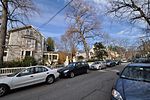Cloverden

Cloverden is an historic house at 29 Follen Street in Cambridge, Massachusetts. It is a 2+1⁄2-story wood-frame structure, five bays wide, with a side-gable roof, two asymmetrically placed chimneys, and clapboard siding. A single-story porch extends across the front, supported by Doric columns. The Greek Revival house was built in 1837.The house served as bachelor housing for Harvard University faculty in the 1850s, and was known as a center of hospitality where "the famous 'Roman Banquet' was given", according to William Watson Goodwin. Prominent occupants include geology professor Josiah Dwight Whitney, and Mary Mann, the mother of education reform proponent Horace Mann.The house was listed on the National Register of Historic Places in 1983.
Excerpt from the Wikipedia article Cloverden (License: CC BY-SA 3.0, Authors, Images).Cloverden
Follen Street, Cambridge
Geographical coordinates (GPS) Address Nearby Places Show on map
Geographical coordinates (GPS)
| Latitude | Longitude |
|---|---|
| N 42.379055555556 ° | E -71.121111111111 ° |
Address
Follen Street 29
02163 Cambridge
Massachusetts, United States
Open on Google Maps








